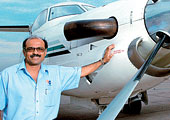 |
|
G.R. GOPINATH
MD/Air Deccan
Started operations:
August 2003
No. of aircraft currently in fleet: 43
No. of cities currently
served: 55
Expected fleet size by 2007-end: 66
Profit in Oct-Dec '06
quarter: Rs 9.64 crore
|
In
Spicejet's operations centre at its office in Gurgaon, company
director and part-owner Ajay Singh is showing off the airline's
impressive on-time performance. Pointing at a board full of numbers,
he queries a nearby employee and tells this correspondent: "Only
one delay today, and that too because of air traffic control (ATC)
issues."
But while SpiceJet, and the three other budget
carriers in India, Air Deccan, Indigo and GoAir, improve their
on-time performance, their financial performance leaves a lot
to be desired. Singh, in whose airline Tata Sons investment arm,
Ewart, recently acquired a 10 per cent stake, laughs when he says:
"No-one is making money, it is a bloodbath, but at least
we are losing less money than the others and even make a marginal
operating profit." SpiceJet, which has a fleet of 11 aircraft
currently, expects to have 17 by year-end.
Another airline that has definitely not slowed
down its growth plans is Indigo Airlines. Promoted by the Delhi-based
travel services firm Interglobe, Indigo burst onto the scene with
a huge 100-aircraft order at the Paris Air Show in 2005. So far,
nine aircraft have been delivered and Bruce Ashby, CEO of the
airline, expects six more by the end of the year. "By 2008,
we should have a fleet of 23 aircraft." However, ask him
if he is making money, and he shrugs: "This is not a business
where you can expect to make money for the first 18-24 months.
In the current environment in India, with infrastructural issues,
that time frame might get slightly extended." However, Ashby
did point out that Indigo hopes to turn the corner soon.
 |
|
BRUCE ASHBY
CEO/Indigo
Started operations:
February 2006
No. of aircraft currently in fleet: 9
No. of cities currently
served: 13
Expected fleet size by 2007-end: 15
Profit in Oct-Dec '06
quarter: NA
|
So what's the problem? "Customers only
care about the lowest fare, there is little price elasticity for
fares on a particular sector," says Jeh Wadia, MD, GoAir.
"And the health of the industry is being compromised by things
like sales tax on aviation turbine fuel (ATF). Over 42 per cent
of my costs today are on ATF; if the government brought ATF under
value-added tax (VAT), we would start making a profit overnight."
GoAir recently reduced its fleet from seven
aircraft to five and the number of stations it serves from 13
to 11. While some in the industry see this as a sign of weakness,
Wadia strongly quashes these rumours. "Our plans were always
to bring in additional capacity every winter, because in winter
we can bring in aircraft that are being underutilised in Europe
at low-lease costs for the peak season in India." Wadia adds
that GoAir expects delivery of its first brand-new aircraft from
Airbus later this year.
 |
|
AJAY SINGH
Director/Spice Jet
Started operations:
May 2005
No. of aircraft currently in fleet: 11
No. of cities currently
served: 14
Expected fleet size by 2007-end: 17
Loss in quarter ending Feb 28, '07: Rs
21.4 crore
|
That said, Ashby and Singh both believe that
a good customer experience can allow airlines to charge a certain
premium. "SpiceJet is rarely the cheapest airline on a particular
sector," Singh points out, while Ashby says: "In this
industry, it is all about getting the job done with no hassles;
if you do that time after time, the word spreads, and it gives
us the ability to charge a slight premium."
Samyukth Sridharan, Principal Sales and Marketing
Officer, Air Deccan, believes that fares will start climbing,
"We believe that the low-cost industry has seen a bottoming
out in costs and we will see prices begin to rise over the next
12-18 months." Air Deccan plans to increase ancillary revenues
to 25 per cent of the company's topline within the next four years.
"That will allow us to fiddle with fares," adds Sridharan.
However, while GoAir, Indigo and SpiceJet
work on the tried and tested single-aircraft type, low-cost model,
Air Deccan utilises its ATR aircraft on smaller sectors, prompting
one rival to quip that the airline was "trying to be a jack
of all trades", Sridharan, however, has confidence in the
model. "We believe the ATRs give us access to smaller airports
and the latent market in tier-II towns."
 |
|
JEH WADIA
MD/GoAir
Started operations:
November 2005
No. of aircraft currently in fleet: 5
No. of cities currently
served: 13
Expected fleet size by 2007-end: 10
Profit/loss last quarter: NA
|
The low-cost bunch has now also to contend
with higher interest rates, which will result in a shrinkage in
disposable incomes among the middle class. "There might be
a short-term impact, but people will still travel in the long
term", Wadia says. Sridharan is more forthright, "The
alternative is to spend hours and even days on a train or bus."
Robey Lal, Country Manager, India, International
Air Transport Association (IATA), believes that India remains
a bright spot for the global aviation industry. "Policy decisions
to liberalise markets have stimulated an enormous market. Consequently,
India ranks amongst the top six fastest growing markets in the
world." However, Lal adds: "In domestic markets, we
see more scope for movement." Gautam Roy, aviation analyst,
Edelweiss Capital, believes that pricing power will only come
back if capacity is reduced. "I believe there needs to be
a degree of common-sense consolidation in the industry. Even though
planes are travelling full, the seats are being sold at unprofitable
prices right now."
A few airlines share that view. "In
the current environment there is space in India for (just) a couple
of budget carriers," Ashby points out. "I think there
is a market for two full-service and two budget carriers, plus
the government airlines and maybe a couple of niche carriers,
so I fully expect some consolidation," Singh adds. Any guesses
on who will still be in business this time next year?
-additional reporting by
rahul sachitanand
|








